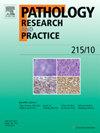下一代测序:随着生物信息框架的出现,临床诊断中的潜在应用。
IF 2.9
4区 医学
Q2 PATHOLOGY
引用次数: 0
摘要
在过去的三四十年里,桑格发现的热释光测序法是截至 2005 年唯一一种无与伦比的全基因组测序(WGS)方法。随后,一种革命性的广泛平行测序方法--下一代测序(NGS)应运而生。NGS 在高通量元基因组检测中支持大量碱基。生物信息学为这一进步做出了显著贡献。它提供了配准工具、组装算法以及 Illumina 和杂交捕获等协议,使临床诊断和转化诊断发生了蜕变。随着 NGS 在表观遗传学、转录组学、突变检测、预后分析、治疗和患者管理等领域的应用,精准医疗和靶向治疗也取得了进展。在实时临床环境中使用 NGS 已被证明能产生积极的结果。NGS 的最新成果是在多重 PCR 的帮助下破解了 SARS-CoV-2 病毒的流行病学。迄今为止,它已被用于检测从低到中不同水平的病毒载量。通过对病毒载量进行扩增和系统发育检查,将病毒与起源时期的进化史联系起来。在执行 NGS 时,测序成本的降低进一步减少了分析所消耗的时间和基因组的广泛大小。借助这篇综述论文,我们希望说明上述因素是如何促进组织、微生物和分子数据分析的。与此同时,通过生物信息学促进和激励对形态和表型研究范例的广泛评估和扩展,可推动个性化和简明临床研究的进一步发展。本文章由计算机程序翻译,如有差异,请以英文原文为准。
Next Generation Sequencing: Latent applications in clinical diagnostics with the advent of bioinformatic frameworks
For the past 3–4 decades, the discovery of Sanger’s method of pyrosequencing was the only method unparalleled till 2005 being employed as a method of whole genome sequencing (WGS). Following this, a revolutionary extensive parallel sequencing method, Next Generation Sequencing (NGS), was engineered. NGS supported a substantial number of bases under a high throughput metagenomic interrogation. Bioinformatics contributed notably to this advancement. It provided alignment tools, assembly algorithms, and protocols such as Illumina and hybridization capture which have metamorphosed clinical and translational diagnostics. With the extension in precision medicine and targeted therapy under NGS sectors such as epigenetics, transcriptomics, mutation detection, prognosis, therapeutics, and patient management have been gaining progress. Using NGS in real-time clinical settings has been proven to produce positive outcomes. The most recent instrumental benefaction of NGS has been decoding the SARS-CoV-2 virus epidemiology with the assistance of multiplex PCR. So far, it had been employed to inspect different levels of viral loads from low to mid. This has been executed by amplification and phylogenetic examination of the load to raise a connective link with the evolutionary history leading up to the period of origin. The depletion in the consumed time and extensive genome size under analysis was further coupled by a cutback in the cost of sequencing while executing NGS. With the aid of this review paper, we aspire to manifest how the above-mentioned elements have boosted, tissue, microbial, and molecular data interrogation. Along with this, promoting, and stimulating an extensive evaluation and expansion in the paradigm of morphological and phenotypic study, via bioinformatics can facilitate further advancement in personalized and concise clinical research.
求助全文
通过发布文献求助,成功后即可免费获取论文全文。
去求助
来源期刊
CiteScore
5.00
自引率
3.60%
发文量
405
审稿时长
24 days
期刊介绍:
Pathology, Research and Practice provides accessible coverage of the most recent developments across the entire field of pathology: Reviews focus on recent progress in pathology, while Comments look at interesting current problems and at hypotheses for future developments in pathology. Original Papers present novel findings on all aspects of general, anatomic and molecular pathology. Rapid Communications inform readers on preliminary findings that may be relevant for further studies and need to be communicated quickly. Teaching Cases look at new aspects or special diagnostic problems of diseases and at case reports relevant for the pathologist''s practice.

 求助内容:
求助内容: 应助结果提醒方式:
应助结果提醒方式:


